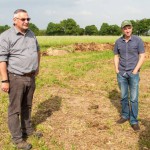Farm description
Climate change mitigation & adaptation is an important topic for Mr. Mautschke as an organic farmer who knows about the challenges of our time: Nature conservation and environmentally friendliness are an important concern. With his activity in the SOLMACC-Project he wants to give a convincing example for other farmers around.
On the Bioland farm Gut Krauscha, Hans-Joachim Mautschke manages around 300 ha of land. His main production are cereals (79 ha), clover grass (54 ha) and legumes (26 ha) besides his permanent grassland (120 ha) and more than 11 ha of hedges. With the beginning of the SOLMACC project, he additionally kept around 70 cows, but stopped animal husbandry in 2018.
Climate friendly practices applied
- Improved on-farm nutrient management
Composting of on-farm residues
The farm composted the farmyard manure from his 70 cows. The produced compost was spread on the most of his arable fields once per year. Therefore, the compost application helped him to close on-farm nutrient cycles.
Composting farmyard manure helps to reduce CH4 and N2O emissions, compared to the emissions of a manure pile. Additionally, compost application helps to reduce fertilizer application in the following years.

Mr. Mautschke, Bioland farm Gut Krauscha
For a farm in the eastern rim of Germany the exchange of experiences is of utmost importance. I want to make use of the changes the project delivers in terms of connections. Hence, it would be important for me to meet my colleagues from Germany but also from Sweden and Italy.
- Optimised crop rotations with legumes
Increasing cultivation of grain and forage legumes
The farmer introduced grain legumes (field peas and lupines) on 16% of his area. Additionally, he extended the clover ley cultivation from one to two years in his crop rotation. By this, 50 % of his arable area is now cultivated with leguminous crops.
Legume crops contribute to N fixation and therefore reduce the amount of fertilizers needed in the following years. By extending the clover cultivation, practices, such as ploughing are done only once every two years instead of every year. This helps to safe fossil fuel consumption.
- Optimised tillage systems
Reduced tillage
Some cultures were managed without tillage (clover, lupine), while for winter wheat and rye the depth of tillage was reduced from 20-25 cm to 10-15 cm. In total, on 86% of the fields, tillage was reduced.
Reducing tillage helps to reduce fossil fuel consumption.
- Agroforestry
Hedgerows and tree strips along agricultural fields
On the farm around 11 ha hedges and tree strips were planted. Part of the woody biomass (in form of woody chips) is used to substitute house heating with fossil fuels.
Trees and hedges help to sequester atmospheric carbon into plant biomass and soils. Therefore, they function as a carbon sink.
Location
Other farms